
What Is Neo?
NEO is the use of blockchain technology and digital identity to digitize assets, the use of smart contracts for digital assets to be self-managed, to achieve "smart economy" with a distributed network.
Digital Assets
Digital assets are programmable assets that exist in the form of electronic data. With blockchain technology, the digitization of assets can be decentralized, trustful, traceable, highly transparent, and free of intermediaries. On the NEO blockchain, users are able to register, trade, and circulate multiple types of assets. Proving the connection between digital and physical assets is possible through digital identity. Assets registered through a validated digital identity are protected by law.
NEO has two forms of digital assets: global assets and contract assets. Global assets can be recorded in the system space and can be identified by all smart contracts and clients. Contract assets are recorded in the private storage area of the smart contract and require a compatible client to recognize them. Contract assets can adhere to certain standards in order to achieve compatibility with most clients.
Digital Identity
Digital identity refers to the identity information of individuals, organizations, and other entities that exist in electronic form. The more mature digital identity system is based on the PKI (Public Key Infrastructure) X.509 standard. In NEO, we will implement a set of X.509 compatible digital identity standards. This set of digital identity standards, in addition to compatible X.509 level certificate issuance model, will also support Web Of Trust point-to-point certificate issuance model.
Our verification of identity when issuing or using digital identities includes the use of facial features, fingerprint, voice, SMS and other multi-factor authentication methods. At the same time, we will also use the blockchain to replace the Online Certificate Status Protocol (OCSP) to manage and record the X.509 Certificate Revocation List (CRL).
Smart Contract
The smart contract was first proposed by the cryptographer Nick Szabo in 1994, only five years after the creation of the World Wide Web. According to Szabo's definition: When a pre-programmed condition is triggered, the smart contract will execute the corresponding contract terms. Blockchain technology provides us with a decentralized, tamper-resistant, highly reliable system in which smart contracts are very useful. NEO has an independent smart contract system: NeoContract.
The Neo-Contract smart contract system is the biggest feature of the seamless integration of the existing developer ecosystem. Developers do not need to learn a new programming language but use C#, Java and other mainstream programming languages in their familiar IDE environments (Visual Studio, Eclipse, etc.) for smart contract development, debugging and compilation.
- Overview - Table of Contents
- What Is Neo?
- Getting Started With Neo
- How To Get A Neo Wallet?
- Neo Resources
- How To Buy Neo?
- Latest Neo News
NEO's Universal Lightweight Virtual Machine, NeoVM, has the advantages of high certainty, high concurrency, and high scalability. The NeoContract smart contract system will allow millions of developers around the world to quickly carry out the development of smart contracts. NeoContract will have a separate white paper describing the implementation details.
Application and Ecosystem
Ecosystem is the vitality of the open source community. In order to achieve the goal of an intelligent economic network, NEO will be committed to the development of its ecosystem, providing mature development tools, improving development of documents, organizing education and training activities, and providing financial support. We plan to support the following NEO-based applications and ecology and to reward improvements to the design of the experience:
- Node Program
- A fully functioning Full node PC program
- A light node PC program with a better user experience
- Web / Android / iOS clients that do not need to synchronize with the blockchain
- Hardware wallet
- Blockchain Explorer
- SDK Development Kit
- Support Java / Kotlin, .NET C # / VB, JavaScript / Typescript, Python, Go
- Smart Contract Compiler and IDE Plugin
- C# / VB.Net / F#, Visual Studio
- Java / Kotlin, Eclipse
- C / C++ / GO
- JavaScript / TypeScript
- Python / Ruby
- Decentralized Applications
- Smart fund
- AI-assisted legal smart contract
- Social networking
- Automated tokens liquidity providers
- Decentralized exchange
- Secure communication protocol
- Data exchange market
- Intellectual property trading market
- Prediction market
- Advertising market
- Hashpower market
- NeoGas market
NEO Management Model
NEO has two native tokens, NEO (abbreviated symbol NEO) and NeoGas (abbreviated symbol GAS).
NEO, with a total of 100 million tokens, represents the right to manage the network. Management rights include voting for bookkeeping, NEO network parameter changes, and so on. The minimum unit of NEO is 1 and tokens cannot be subdivided.
GAS is the fuel token for the realization of NEO network resource control, with a maximum total limit of 100 million. The NEO network charges for the operation and storage of tokens and smart contracts, thereby creating economic incentives for bookkeepers and preventing the abuse of resources. The minimum unit of GAS is 0.00000001.
In the genesis block of the NEO network, 100 million NEOs are generated, GAS has not yet been generated. 100 million GAS, corresponding to the 100 million NEO, will be generated through a decay algorithm in about 22 years time to address holding NEO. If NEO is transferred to a new address, the subsequent GAS generated will be credited to the new address.
The NEO network will set a threshold by voting to exempt GAS from a certain amount of transfer transactions and smart contract operations to enhance the user experience. When a large amount of spam transactions occur, NeoID can be used to prioritize transactions and smart contracts with qualified identities. Transactions and smart contracts with no qualifying digital identities can get priority by paying GAS.
Distribution Mechanism
NEO distribution:
NEO's 100 million tokens is divided into two portions. The first portion is 50 million tokens distributed proportionally to supporters of NEO during the crowdfunding. This portion has been distributed.
The second portion is 50 million NEO managed by the NEO Council to support NEO's long-term development, operation and maintenance and ecosystem. The NEO in this portion has a lockout period of 1 year and is unlocked only after October 16, 2017. This portion will not enter the exchanges and is only for long-term support of NEO projects. The plans for it are as below:
- 10 million tokens (10% total) will be used to motivate NEO developers and members of the NEO Council
- 10 million tokens (10% total) will be used to motivate developers in the NEO ecosystem
- 15 million tokens (15% total) will be used to cross-invest in other block-chain projects, which are owned by the NEO Council and are used only for NEO projects
- 15 million (15% total) will be retained as contingency
- The annual use of NEO in principle shall not exceed 15 million tokens
GAS distribution:
GAS is generated with each new block. The initial total amount of GAS is zero. With the increasing rate of new block generation, the total limit of 100 million GAS will be achieved in about 22 years. The interval between each block is about 15-20 seconds, and 2 million blocks are generated in about one year.
Each year around 2 million blocks will be generated and the initial generation will be 8 GAS per block. There will be an annual reduction of 1 GAS per block, per year, to coincide with the passing of every 2 million blocks. The reduction will continue down to just 1 GAS per block and will be held at that rate for around 22 years. After the 44 millionth block the total GAS generated will have reached 100 million and from this point there will be no further generation of GAS from new blocks.
According to this release curve, 16% of the GAS will be created in the first year, 52% of the GAS will be created in the first four years, and 80% of the GAS will be created in the first 12 years. These GAS will be distributed proportionally in accordance with the NEO holding ratio, recorded in the corresponding addresses. NEO holders can initiate a claim transaction at any time and claim these GAS tokens at their holding addresses.
Governance mechanism
Chain governance: NEO token holders are the network owners and managers, managing the network through voting in the network, using the GAS generated from NEO to utilize the functions in the network. NEO tokens can be transferred.
Off-chain governance: NEO Council consists of the founding members of the NEO project, under which the management committee, technical committee and the secretariat, respectively, are responsible for strategic decision-making, technical decision-making and specific implementation. The NEO Council is responsible to the NEO community for the promotion and development of NEO ecosystem as its primary objective.
NEO technology implementation
Consensus mechanism: dBFT
The dBFT is called the Delegated Byzantine Fault Tolerant, a Byzantine fault-tolerant consensus mechanism that enables large-scale participation in consensus through proxy voting. The holder of the NEO token can, by voting, pick the bookkeeper it supports. The selected group of bookkeepers, through BFT algorithm, reach a consensus and generate new blocks. Voting in the NEO network continues in real time, rather than in accordance with a fixed term.
The dBFT provides fault tolerance of f = ⌊ (n-1) / 3 ⌋ for a consensus system consisting of n consensus nodes. This fault tolerance also includes both security and availability, resistant to general and Byzantine failures, and is suitable for any network environment. dBFT has good finality, meaning that once confirmations are final, the block can not be bifurcated, and the transaction will not be revoked or rolled back.
- Overview - Table of Contents
- What Is Neo?
- Getting Started With Neo
- How To Get A Neo Wallet?
- Neo Resources
- How To Buy Neo?
- Latest Neo News
In the NEO dBFT consensus mechanism, taking about 15 to 20 seconds to generate a block, the transaction throughput is measured up to about 1,000TPS, which is excellent performance among the public chains. Through appropriate optimization, there is potential to reach 10,000TPS, allowing it to support large-scale commercial applications.
The dBFT combines digital identity technology, meaning the bookkeepers can be a real name of the individual or institution. Thus, it is possible to freeze, revoke, inherit, retrieve, and ownership transfer due to judicial decisons on them. This facilitates the registration of compliant financial assets in the NEO network. The NEO network plans to support such operations when necessary.
Smart contract system: NeoContract
NEO's smart contract system consists of three parts:
NeoVM - Universal Block Chain Virtual Machine:
NeoVM is a lightweight, general-purpose virtual machine whose architecture is very close to the JVM and .NET Runtime, similar to a virtual CPU that reads and executes instructions in the contract in sequence, performs process control based on the functionality of the instruction operations, logic operations and so on. It has a good start-up speed and versatility, is very suitable for small programs such as smart contracts, can also be ported to non-blockchain systems, or integrated with the IDE to provide an optimal development experience. NeoVM's functionality can be extended, like introducing a JIT (real-time compiler) mechanism, thereby enhancing the efficiency of the implementation.
InteropService - Interoperable Services:
Used to load the blockchain ledger, digital assets, digital identity, persistent storage area, NeoFS, and other underlying services. They are like virtual machines that are provided for virtual machines, enabling smart contracts to access these services at run time to achieve some advanced functionality. Through this low-coupling design, NeoVM can be ported to any blockchain or even non-blockchain system used, increasing the utility of the smart contracts.
DevPack - Compiler and IDE plugin:
DevPack includes the high-level language compiler and the IDE plug-in. Because NeoVM's architecture is very similar to JVM and .NET Runtime, the compilers in DevPack can compile Java byte code and .NET MSIL into NeoVM's instruction set. Java / Kotlin, C# developers do not need to learn new languages and will be able to immediately start developing smart contracts in VS, Eclipse and other familiar IDE environments. This greatly reduces the learning curve for developing smart contracts, allowing us to easily build a vibrant community around NeoContract.
NeoContract can create a smart contract call tree through static analysis before running a smart contract. Through the deterministic call tree, the NEO node can dynamically fragment the smart contract to achieve theoretically unlimited expansion, which overcomes the "jamming effect" caused by the static fragmentation of other block chain systems.
Cross-chain interoperability agreement: NeoX
NeoX is a protocol that implements cross-chain interoperability. NeoX is divided into two parts: "cross-chain assets exchange protocol" and "cross-chain distributed transaction protocol."
Cross-chain assets exchange agreement:
NeoX has been extended on existing double-stranded atomic assets exchange protocols to allow multiple participants to exchange assets across different chains and to ensure that all steps in the entire transaction process succeed or fail together. In order to achieve this function, we need to use NeoContract function to create a contract account for each participant. If other blockchains are not compatible with NeoContract, they can be compatible with NeoX as long as they can provide simple smart contract functionality.
Cross-chain distributed transaction protocol:
Cross-chain distributed transactions mean that multiple steps of a transaction are scattered across different blockchains and that the consistency of the entire transaction is ensured. This is an extension of cross-chain assets exchange, extending the behavior of assets exchange into arbitrary behavior. In layman's terms, NeoX makes it possible for cross-chain smart contracts where a smart contract can perform different parts on multiple chains, either succeeding or reverting as a whole. This gives excellent possibilities for cross-chain collaborations and we are exploring cross-chain smart contract application scenarios.
Distributed Storage Protocol: NeoFS
NeoFS is a distributed storage protocol that utilizes Distributed Hash Table (DHT) technology. NeoFS indexes the data through file content (Hash) rather than file path (URI). Large files will be divided into fixed-size data blocks that are distributed and stored in many different nodes.
The main problem with this type of system is the need to find a balance between redundancy and reliability. NeoFS plans to solve this contradiction by means of token incentives and the establishment of backbone nodes. Users can choose the reliability requirements of the file. Files with low reliability requirements can be stored and accessed for free or almost free. Stable and reliable services for files with high reliability requirement will be provided by backbone nodes.
NeoFS will serve as one of the InteropService interoperability services under the NeoContract system, enabling smart contracts to store large files on the blockchain and set access for those files. In addition, NeoFS can be combined with digital identity so that digital certificates used by digital identities can be assigned, sent, and revoked without a central server to manage them. In the future, the old block data can be stored in NeoFS, so that most of the full nodes can release the old data for better scalability and at the same time, ensure the integrity of historical data.
Anti-quantum cryptography mechanism: NeoQS
The emergence of quantum computers poses a major challenge to RSA and ECC-based cryptographic mechanisms. Quantum computers can solve the large number of decomposition problems (which RSA relies on) and the elliptic curve discrete logarithm (which ECC relies on) in a very short time. NeoQS (Quantum Safe) is a lattice-based cryptographic mechanism. At present, quantum computers do not have the ability to quickly solve the Shortest Vector Problem (SVP) and the Closest Vector Problem (CVP), which is considered to be the most reliable algorithm for resisting quantum computers.
Summary
NEO is a distributed network that combines digital assets, digital identities and smart contracts. The NEO system will use DBFT, NeoX, NeoFS, NeoQS and many other original technologies, as the infrastructure for the intelligent economy of the future.
Getting Started With Neo
NEO is a non-profit community-based blockchain project that utilizes blockchain technology and digital identity to digitize assets, to automate the management of digital assets using smart contracts, and to realize a "smart economy" with a distributed network.
NEO was founded in 2014 and was real-time open source on GitHub in June 2015. Since its inception, the NEO team has experienced the upsurge and boom of the blockchain industry and the frenzy and cooling of the digital money market. We believe technology drives progress and together we can create the future. Motivated by this, NEO has been created to shift our traditional economy into the new era of the "Smart Economy".
Digital Assets - Digital Assets are programmable assets that exist in the form of electronic data. With blockchain technology, the digitization of assets can be decentralized, trustful, traceable, highly transparent, and free of intermediaries. On the NEO blockchain, users are able to register, trade, and circulate multiple types of assets. Proving the connection between digital and physical assets is possible through digital identity. Assets registered through a validated digital identity are protected by law.
Digital Identity - Digital identity refers to the identity information of individuals, organizations, and other entities that exist in electronic form. The more mature digital identity system is based on the PKI (Public Key Infrastructure) X.509 standard. In NEO, we will implement a set of X.509 compatible digital identity standards. This set of digital identity standards, in addition to a compatible X.509 level certificate issuance model, will also support the Web Of Trust point-to-point certificate issuance model.
Smart Contract - The NeoContract smart contract system is the biggest feature of the seamless integration of the existing developer ecosystem. Developers do not need to learn a new programming language, but can use C#, Java and other mainstream programming languages in their familiar IDE environments (Visual Studio, Eclipse, etc.) for smart contract development, debugging and compilation. NEO's Universal Lightweight Virtual Machine, NeoVM, has the advantages of high certainty, high concurrency, and high scalability. The NeoContract smart contract system will allow millions of developers around the world to quickly carry out the development of smart contracts. NeoContract will have a separate white paper describing the implementation details.
NEO was commonly known by its first and original name “Antshares” when it was launched under that same name back in 2014. Later on, NEO developers changed the mane to NEO, a name under which this coin is now widely known and recognized by. They have particularly chosen this name because it means novelty, new and youth in Greek, that way somewhat inviting novelties into the “career” of this, now striving coin.
NEO was designed based on blockchain technology, and at the same time it represented China’s first digital coin and soon to be one of the top ten world’s digital values. China’s attitude towards the global coin market can also be easily seen through based on the nicknames this currency was given and they also call it – Ethereum killer or China’s Ethereum.
- Overview - Table of Contents
- What Is Neo?
- Getting Started With Neo
- How To Get A Neo Wallet?
- Neo Resources
- How To Buy Neo?
- Latest Neo News
As you know, Ethereum is one of the most significant coins in the world with a decentralized community that has no borders and where almost any sort of trading and doing business is possible through blockchain technology and smart contracts. You can sell your house on Ethereum, purchase numerous services and products, make free and prompt transactions and enjoy the perks of a large and functional community supporting this decentralized network.
NEO is aiming at creating a community much like Ethereum, with a drive of potentially reaching proportions of popularity and increased interest that goes beyond the current fame and status Ethereum has as one of the biggest and most wanted coins in the market. NEO platform is as well decentralized and operating based on blockchain technology, and as well as Ethereum, NEO has more than one currency allowed into the system of trading within the community.
The second currency that can be used within NEO community is called GAS. GAS tokens are being created with each generated block in blockchain while holding the value set by the market. There is a difference though between NEO and GAS when it comes to value and hierarchy. While NEO represents the primary source of value as well as the ownership over NEO blockchains, GAS solely represents a value that allows you to participate in the system.
Based on all features and functionality of NEO and GAS, you can conclude that NEO represents a decentralized community that is designed to make doing business and performing transactions a lot easier. This resembles Ethereum and the way this network works, having NEO also using smart contracts in an utterly secured environment that guarantees safe payments and the possibility to exchange any value, including real estate, shares and anything that might be valuable.
Ethereum VS NEO
Since both of these coins are competing for the same market, we thought it would be interesting to compare these two digital assets and the way both assets work. With NEO holding the 10th place and Ethereum holding the 2nd it is without a doubt clear that Ethereum is in the lead there, being among top coins for a long time without letting go of the 2nd spot on the list.
If we ought to compare prices of these two coins, NEO is worth 141$ per one coin, while Ethereum is worth the fantastic 1318$ per one unit. Ethereum is thus leading when it comes to price as well. But then we can see that in the last 24 hours Ethereum had a slight decrease of -2.88% while NEO experienced an increase of 7% which led it to the price it is now being traded at.
Just a year ago, NEO had a long way to go to be even able to compete with the big guys like Ethereum, but now this coin has taken 10th place on the global coin ranking list and is experiencing increases that are benevolently affecting this coin’s price as well as popularity and demand. We can quickly conclude that NEO is aiming at the top, slowly but steadily going up and growing with a broader community of holders, users and investors.
Already being China’s number one coin, also making it their first and most significant coin that has a decentralized environment and its own official GAS tokens, NEO could easily replace Ethereum if it is given the opportunity. The only thing that could resolve the issue of who’s the best in technology these coins are using.
At the end holders and users will decide that whichever coin has the most functionality, the lowest fees, and better technology would be the one having the most active wallets, which is in the end what counts when it comes to experiencing decreases and increases in price. Whichever coin is less sold and more used is the one that will get the opportunity of climbing the ladder to the top spot where the best rest. For now, the crown still belongs to Ethereum, but the time will show whether or not this situation is going to change.
How To Get A Neo Wallet?
Top 8 Best NEO Wallets
1. Ledger Nano S
If you are holding NEO for the mid-term or long-term, hardware wallet is your best bet to keep it secure and safe from preying eyes of the hackers. Ledger Nano S added support for NEO wallet in last quarter of 2017 and it works with the NEON wallet. You will also be able to claim your earned GAS using Ledger Nano S + NEON combination. Out of all the NEO wallets listed here, this is the most secure wallet.
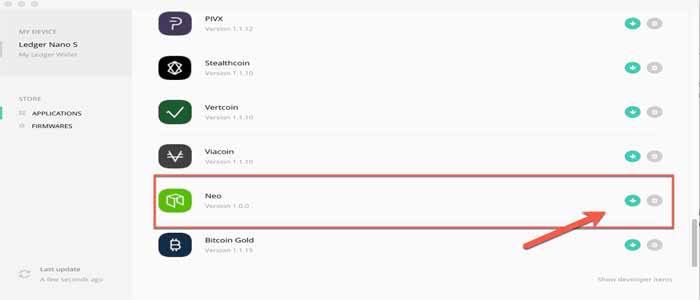
The best thing that I liked after using the combination of Ledger Nano S + Neon wallet is; I don’t have to enter the private key or keep it on my computer. This reduces the chances of getting hacked by a great extent. Apart from that, one can send NEO or GAS only when they have access to my Ledger Nano S hardware device which makes it most secure wallet for holding Neo.
Here is a video tutorial showing how to use Ledger Neon Wallet:
2. NEON Wallet (Desktop Wallet)
NEON Wallet is one of the best NEO wallets available right now in the market. It allows you to store, receive, and send both NEO assets i.e. (NEO & GAS).
The awesome thing about it is that you can claim your automatically generated GAS if you hold NEO cryptocurrency in the NEON Wallet.
While using the NEON Wallet for your NEO funds, you need not worry about security because your private keys are never stored on NEON’s servers. This means you control your funds.
I personally use this wallet and like it very much because of all these features.
This wallet was not developed by NEO developers (City Of Zion), but NEO developers have reviewed it thoroughly and found it to be 100% safe.
The NEON lightweight client is available currently on Windows, Mac, and Linux (in English only).
Download NEON Wallet for Windows, Mac, or Linux, and also check out the introductory video of NEON Wallet below:
3. Binance (Web Wallet)
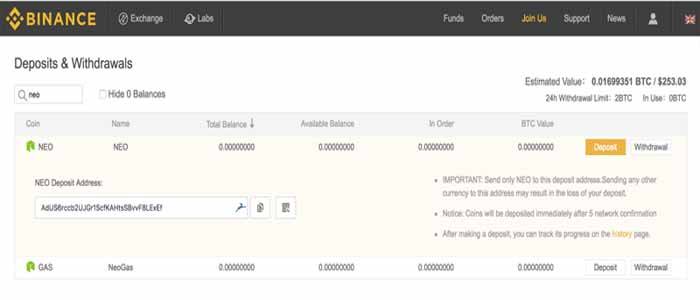
Binance as well all know is a fast growing exchange for buying/selling cryptocurrencies from anywhere in the world.
Binance exchange also has numerous inbuilt wallets for HODLing different cryptocurrencies but there is a special thing about NEO wallet of Binance.
The NEO wallet of Binance also gives you access to the NeoGAS tokens on the 2nd of each month which is not done by any exchange wallet so far now.
That’s why HOLDing your NEO in Binance’s NEO wallet is highly rewarding unlike keeping it on other exchanges.
Note: However we are not telling you explicitly to go and store your NEO in a centralized exchange instead we are giving you an option if you are already holding your NEO in an exchange.
4. NEO GUI (Desktop Wallet)
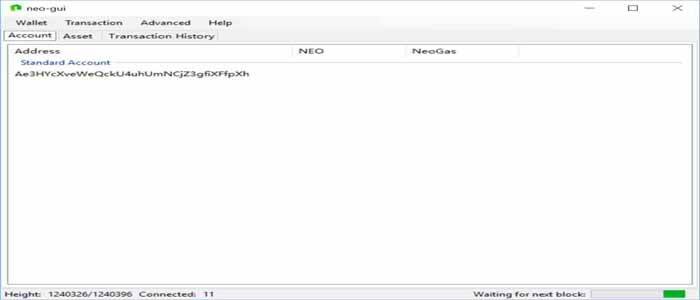
This is the official desktop wallet for NEO developed by NEO developers.
It is a GUI wallet, meaning it will allow you to use it by interacting with a graphical user interface.
It is a synchronizing wallet, which means it will take some time to sync with the entire NEO blockchain. Once the sync is complete, you can make a new wallet with password protection and also take a back up of your wallet by importing your private key in WIF or HEX format.
As expected, this wallet will also allow you to store and transact in both NEO and GAS along with GAS generation rewards for holding your NEO tokens.
At present, it is available only for Windows 7 SP1 and later (in English and Chinese).
5. NEO Tracker (Web Wallet)
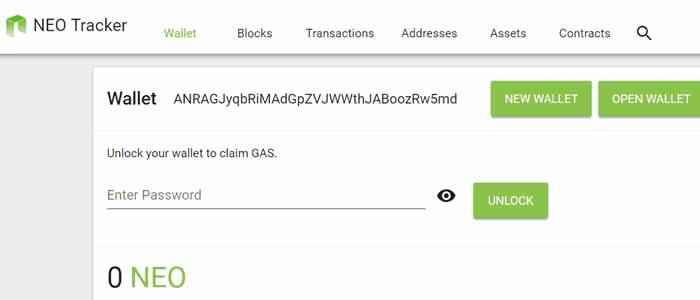
NEO Tracker Wallet is a web-based wallet. It is written in Javascript and is an open-source project. It is a user-friendly application for storing, sending, and receiving NEO and GAS. It also allows its users to claim GAS for the amount they are holding in NEO.
It is officially an offline wallet as it uses your machine’s browser to generate the necessary data, and nothing is ever stored on NEO Tracker’s servers.
It was not developed by NEO developers, but it uses some best practices to ensure the safety of your funds. When you generate a NEO wallet using this, it gives you a keystore file to download which contains your keys in an encrypted form.
NEO Wallet (Web Wallet)
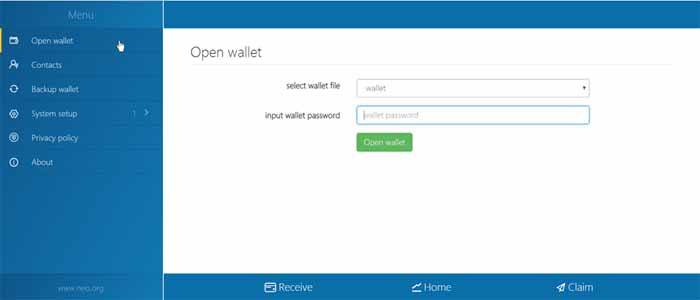 </center
</center
NEO Wallet is a lightweight wallet developed and maintained by the NEO community. Though being a web wallet, it takes care of your NEO funds as nothing is ever sent to NEO Wallet’s servers. It allows you to create a wallet back up so that you control your private keys of your NEO funds.
In this wallet, you can store, send, and receive both NEO and GAS. It also allows you to claim GAS generation for holding your NEO tokens.
It is currently available through Chrome/Edge browsers (in English and Chinese).
7. Ansy (Paper Wallet)
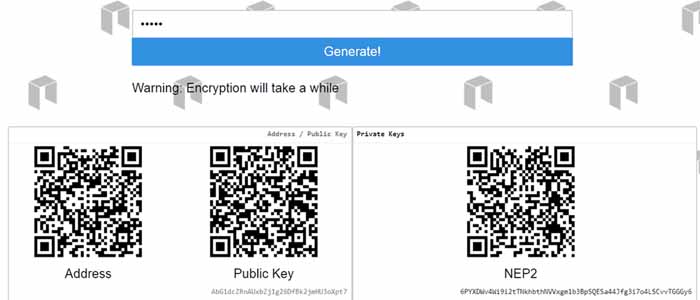
Neo paper wallets are pieces of paper with the public address and the private address printed on them.
You can use the public address to send any amount of NEO to this wallet. The paper also contains a private address for you to use when you want to spend your tokens.
Since the keys are offline, printed, and secured by the owner, there is no threat of loss as long as the paper is secured.
You can use this for storing and spending NEO and GAS, but you won’t be able to claim GAS generated tokens with this wallet.
It is currently available through Chrome/Edge browsers (in English only).
8. NEOWallet (Web Wallet)
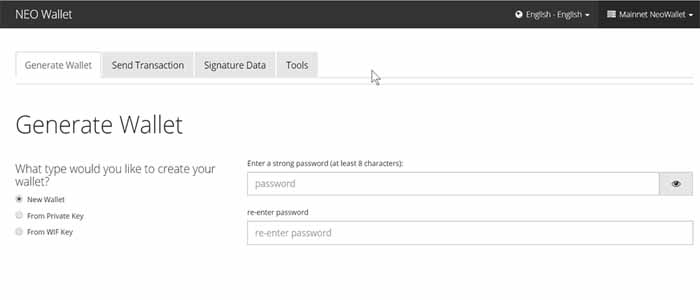
NEOWallet is a free, open source light wallet developed by OnChain developers. It is a secured web wallet which doesn’t store your private keys.
You can store/transact in NEO/GAS and can also claim your generated GAS if you are holding NEO in this wallet.
It is currently available for access through Chrome/Edge browsers (in English and Chinese).
NEO CLI (Desktop Wallet)
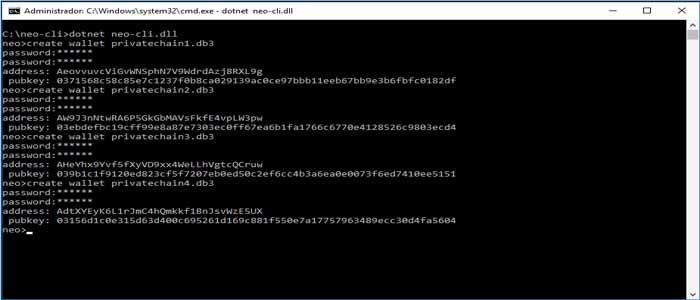
This is another official NEO wallet developed and maintained by the NEO team. The difference is that this is a CLI wallet, meaning it’s controlled by Command line prompts.
This wallet is for advanced users who are comfortable with the Command language. In this wallet, you can store, send, and receive both NEO and GAS. It also allows you to claim GAS generated tokens for holding your NEO tokens here.
At present, it is available only for Windows and Linux (in English only).
Neo Resources
How To Buy Neo?
NEO, previously known as Antshares, is the first open source cryptocurrency launched in China in 2014. 100 million NEO coins were issued. NEO changed the name on 22nd June 2017, with NEO being the Greek word for newness, novelty, and youth. Chinese Ethereum and Ethereum’s killer are also names given to NEO.
NEO has one more crypto-token called GAS, which was formerly known as ANC-Antcoins. A total of 100 million GAS tokens are available for production, each GAS token generated with the creation of each block. It is estimated that it will take approximately 22 years for the number of GAS tokens to increase from 9 million to 100 million.
The difference between NEO coins and GAS tokens is that NEO represents the ownership of the NEO blockchain, while GAS gives the right to use the system.
NEO is a non-profit community-based blockchain project that utilizes blockchain technology and digital identity to digitize assets, to automate the management of digital assets using smart contracts, and to realize a “smart economy” with a distributed network.
How to Buy NEO – The Chinese Ethereum?
The first step in order to buy NEO is to open a digital wallet that stores NEO and GAS.
Open NEO Digital Wallet
Luckily, open a digital for NEO coin is not a complicated process. Here are some of NEO wallets that allow you to store the currency.
The official NEO wallet – The official NEO community wallet. Available for mobile, desktop and web.
Binance – Binance is an exchange and a web wallet with the advantage to trade and store your cryptocurrencies, although it’s safer to transfer your NEOs to a safe digital wallet after your purchase through Binance.
Ledger Nano S – A hardware wallet AKA cold wallet. The ledger is the best option to keep your cryptocurrencies safe and secure.
NEO Tracker – A ‘light’ web wallet that has been developed independently from NEO and allows NEO holders to interact with and explore the NEO blockchain via the web.
NEON Wallet – Beneficial to hold your NEO in this wallet as it allows you to claim your GAS.
Buy NEO with Credit Cards and Fiat Currencies
Depending upon the exchange, not many exchanges allow the purchase of NEO coins with regular money which makes the process easier as one can pay with a credit card or wire transfer while others only allow the purchase of NEO coins with other cryptocurrencies such as Bitcoin or Ethereum.
Currently, the only exchange that accepts fiat money (USD, EUR, GBP, etc.) in order to purchase NEO is Hitbtc.
Where to Buy NEO with Bitcoin or Ethereum?
When looking to purchase NEO coins with Bitcoin or Ethereum, buyers can purchase directly on the exchange and then transfer it to another any exchange that supports NEO. In that case, we recommend finding an exchange that supports Bitcoin and NEO such as Hitbtc.
Buying Bitcoin or Ethereum is particularly easy with methods of payment including credit card, bank transfer, and Skrill. Here is a list of recommended exchanges:
- Coinbase
- Changelly
- LocalBitcoin
- CEX.IO
- Coinmama
Now, after you purchased Bitcoin or ETH, you can open an account in any of the below exchanges, search for NEO/BTC or ANS/BTC and then apply the transaction.
- HitBTC
- Cryptopia
- Binance
Can NEO Overcome Ethereum?
This is probably the first question to ask when considering NEO’s future and potential. The two, NEO and Ethereum are fighting for the same position in the ICO market and the crypto world. Eventually, it will be the technology that determines which one prevail.
There is no doubt that in some aspects, the technology of NEO is better than Ethereum. Yet, Ethereum has been a founder of the ICO market and established a well-known platform. That’s a hard competition for NEO.
A big tip: NEO can thrive should China’s ICO market will reopen for crowdfunding. In that case, one thing to consider in the future is that if China cancels the ICO’s ban, NEO is a strong buy.
- Overview - Table of Contents
- What Is Neo?
- Getting Started With Neo
- How To Get A Neo Wallet?
- Neo Resources
- How To Buy Neo?
- Latest Neo News
In terms of YTD return, Ethereum may be the front-runner in the ICO market, being the founding crypto of the industry, but it is far from the best performer in the market. NEO investors would have made 38,521% year-to-date compared with Bitcoin’s 18,739% gain.
Latest Neo News
A Statement from NEO Council
Da Hongfei, Founder of NEO, explains with below facts to answer the questions and clarify recent confusion regarding NEO dBFT consensus mechanism, the latest block delay, as well as NEO's plan for the decentralization of consensus nodes.
Facts about NEO's consensus mechanism dBFT:
1) dBFT is short for delegated Byzantine Fault Tolerance. Delegation means NEO (the governance token) holders do not participate in the consensus process directly. Instead, NEO holders vote in Consensus Nodes by a special voting transaction.
2) Elected Consensus Nodes reach consensus block by block in a BFT style algorithm. The list of elected Consensus Nodes for the next block can be deterministically calculated from voting transactions in historical blocks including the latest block.
3) The number of Consensus Nodes is also set by the same voting process of NEO holders, from 7 at minimum to 1024 at maximum.
4) Currently NEO Council is managing almost 50% of all the NEO tokens as described in whitepaper from day 1.
5) NEO Council values efficiency (quick response and protocol upgrade) over decentralization (sometimes a crypto-political correctness) at this early stage. Therefore we used tokens and influences we have and voted in 7 Consensus Nodes managed by NEO Council in the past.
6) NEO has hundreds (if not thousands) of full nodes online at any given time, though the exact number is difficult to measure due to its peer-to-peer nature. We are happy with this level of redundancy and believe further redundancy adds little value to the network considering correspondent network/storage/computing resources needed.
7) When NEO's core protocol stabilizes, we expect to see one to a few dozens of Consensus Nodes to be elected by NEO holders. In 2018, we predict the number of Consensus Nodes will stay at 7 to 13.
Facts about NEO's recent delay of block producing:
1) The delay is not out of the reason described by the statement of Malcolm Lerider in Discord, although he is NEO's Senior R&D Manager. His statement was then misused as evidence that 1 Consensus Node failure will bring down the NEO network. It is a ridiculous and ignorant accusation and can be debunked easily. The actual reason is more complicated and we were aware of this issue and had been working on it long before the recent delay happened. Malcolm also wrote a blog to clarify this although the blog simplifies technical details quite a lot.
https://medium.com/@MalcolmLerider/shoutout-to-take-responsibility-5717dc72367a
2) One or even two Consensus Nodes going offline or colluding maliciously will not trigger this issue because dBFT tolerates "f" (in NEO's case f=2) faulty nodes given there are "3f+1" (in NEO's case 7) Consensus Nodes. We are pretty sure the block delay is caused by a corner case lying deep in NEO's p2p protocol implementation: in some unusual scenarios, Consensus Nodes disconnect from the networks temporarily but reconnect shortly after. In such scenarios block delay is observed. We had been testing fixes for weeks on testnet and it was planned to be deployed on mainnet this week.
3) It is not rare to see bugs or even critical ones in software development practice. The advantage of dBFT was indeed displayed in this case because it values finality and consistency over liveness. Even if there is a bug in p2p protocol and caused network stagnation, consensus fork never happened and no transactions need to be reversed. Our design goal is not to maintain a liveness illusion at the cost of causing transactions in one fork to be abandoned -- and yes it happened with other blockchains in the history -- innocent people in an unfortunate fork got transactions abandoned and lost money in the end.
Facts about NEO's plan to decentralize Consensus Nodes:
1) NEO has a plan to decentralize Consensus Nodes and it was released with details at NEO DevCon 1 in San Francisco in Jan. 2018.
2) Many prestigious organizations volunteered to manage Consensus Nodes and NEO Council had already been working with them on testnet or in private networks. Among them are: KPN, one of the biggest telecommunication companies in Netherland; CoZ, the biggest NEO community developer's group; Fenbushi Capital/Wanxiang Blockchain Lab, the biggest and most successful blockchain evangelist and VC in China. They have a high probability to be elected on mainnet in the future.
3) NEO Council had been spending the reserved NEO tokens to accelerate development, reward community, and foster ecosystem. Decreasing amount of NEO held by NEO Council means decreasing voting power, and eventually all NEO tokens aka governance power will be distributed to the community.
4) One of the goals of blockchain is to build technology-empowered trust that can be verified by anyone. Decentralization is a great path to accomplish that, but there are also other considerations and options, especially when the technology and industry are still relatively immature. NEO Council can vote in more Consensus Nodes or just hand over all the Consensus Nodes right away. However, we don't think it's a responsible action in any sense. We don't want NEO's community to be disrupted by crypto-politicians representing interest groups like happened elsewhere. I, myself am an optimistic pessimist, a pragmatic idealist. We don't just imagine how an ideal world looks like, we work out the path from where we are today to the beautiful tomorrow world. The path won't be straight. Just like what we've made clear to NEO community at the very beginning -- the process of complete decentralization takes years, not months or weeks. The road is not always smooth and broad, the sea is not always calm and unruffled, but for enterprising minds that's where the fun comes from. Let's enjoy the journey!
- Overview - Table of Contents
- What Is Neo?
- Getting Started With Neo
- How To Get A Neo Wallet?
- Neo Resources
- How To Buy Neo?
- Latest Neo News
Above information had been publicly discussed/addressed in speaking or written form in numerous situations on social media, industry conferences, and community meetups, across different continents. We are sorry to see that FUD is spreading among those who are not aware of or agree with NEO's vision and philosophy. We hope these facts will help people to understand NEO Council's standpoint on relative issues.
